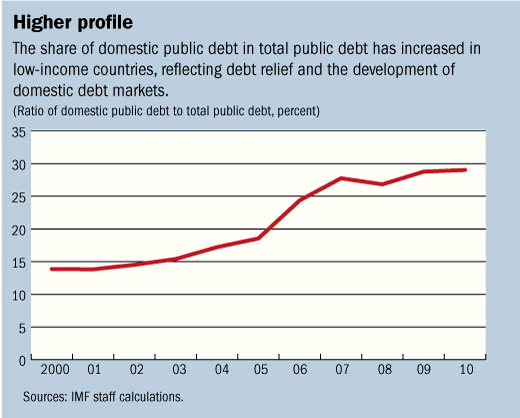
Typical street scene in Santa Ana, El Salvador. (Photo: iStock)
IMF Survey: Assessing Debt Levels in Poorer Countries
March 28, 2012
- Comprehensive review of approach by World Bank, IMF
- Framework to be adapted to changing circumstances n low-income countries
- Analysis of total public debt, investment-growth linkages to be strengthened
Following a comprehensive review, the IMF and World Bank are introducing improvements to their joint Debt Sustainability Framework (DSF) developed to assess borrowing levels in low-income countries.

IMF, World Bank debt sustainability analysis uses models to more adequately capture benefits of debt-financed public investment (photo: Simon Maina/AFP)
DEBT SUSTAINABILITY ANALYSIS
In response to feedback from a range of stakeholders, the IMF and World Bank have determined that some enhancements are necessary to ensure that the framework adapts to changing circumstances in borrowing countries.
Used by borrowers and lenders
The framework is used by borrowing countries, lenders, and donors to assess how much debt is sustainable and to balance it against a country’s development needs. The World Bank relies on the DSF to determine the share of grants and loans in its assistance to low-income countries. Other lenders and donors similarly look to the DSF to inform their financing decisions.
Following the review, the two institutions have decided on a number of enhancements to the framework:
• Strengthened analysis of total public debt and fiscal vulnerabilities
• Adjustment of thresholds on external public debt
• Introduction of an additional risk rating to reflect the overall risk of debt distress
• Better capturing of investment-growth linkages; and
• Making the framework easier for countries to use.
Under the framework, the IMF and World Bank produce a joint debt sustainability analysis (DSA) for all low-income countries, generally on an annual basis. Each DSA yields a rating denoting the risk of external public debt distress. Since introduction of the framework in 2005, nearly 400 DSAs have been produced for over 70 countries, enabling the IMF and World Bank to integrate fiscal and debt issues more effectively into their policy advice and program design.
So far, the framework has worked reasonably well. Debt sustainability in low-income countries has been broadly maintained, and the tool is recognized and used by a growing community of lenders and donors. Nevertheless, as countries’ needs and opportunities evolve, the framework will be adapted.
Key enhancements
Strengthening the analysis of total public debt and fiscal vulnerabilities. Analyses of debt sustainability have traditionally focused on external public debt. Although external public debt remains the largest component of debt in most low-income countries, the share of domestic public debt in total public debt has increased, reflecting debt relief and the development of domestic debt markets (see chart). In some countries, the level of domestic debt to GDP is substantial, or is growing rapidly. In this context, the DSF will need to pay closer attention to the risks associated with total public debt, both external and domestic. Henceforth, the framework will include benchmarks for total public debt that will be used to determine when deeper analysis should be conducted.

Adjusting the thresholds on external public debt. DSAs contain thresholds that signal heightened risk of external public debt distress. The thresholds were derived in 2004 based on empirical work by IMF and World Bank staff. Staff recently re-estimated the thresholds using more recent data and improved empirical techniques. The results of the work validated the main finding from 2004—namely, that countries with strong policies and institutions can sustain a higher debt burden than those with weak policies and institutions. Most of the thresholds will be maintained at their current values, while a few will be revised modestly.
Introducing an additional risk rating to reflect the overall risk of debt distress. For countries with significant vulnerabilities related to domestic public debt or private external debt, an additional risk rating will be introduced that provides an overall assessment of debt vulnerability. The additional risk rating will complement the existing risk rating on external public debt and will inform the macroeconomic and structural policy dialogue with country authorities.
Better capturing investment-growth linkages. A recurring criticism of the DSF by some observes has been that it does not adequately capture the benefits of debt-financed public investment, thus leading to overly conservative risk assessments that constrain low-income countries from meeting their development goals. In response, the IMF and World Bank have developed complementary models that look more closely at the relationship between growth and investment. These models will be applied more broadly in future DSAs.
Creating a more user-friendly framework. Producing a DSA can be challenging, in part due to the complexity of the tool. The Bank and Fund will revamp the user interface in order to facilitate the use of the tool by country authorities.


